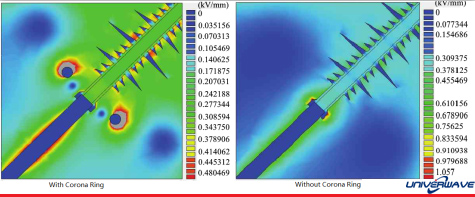


Welcome to this site!Shanghai Univerwave Co.,Ltd

www.univerwave.cn 丨HV Testing
Technology create the future
Let us work together
How corona ring works?
Source:
|
Author:佚名
|
Published time: 2021-03-04
|
94 Views
|
Share:
When the electric field at one point in the air is strong enough, some electrons are stripped from the atoms, and the air becomes a conductive plasma rather than an insulator.
When the electric field at one point in the air is strong enough, some electrons are stripped from the atoms, and the air becomes a conductive plasma rather than an insulator. When an object is under high voltage and has a small curvature (wire, tip), the field in the surrounding area may have a high enough field intensity for this to occur, thus forming a conductive layer of air, which is then surrounded by normal insulating air. If the intensity around this conductive layer is also high enough (if the conductive region is sharp), the conductive layer can increase and increase in size (usually in one direction) until a full conductive path to another object is formed, and then a large current flows in the form of an arc.
Even if the shape of the field does not form an arc, it can still form a corona discharge. This is when the conductive layer of the plasma stops expanding and is located only around the wire, and the ions in the plasma layer are repulsed into neutral air, where they drift slowly until they discharge on another object. This is still an electric current, only much less than an arc.
The corona ring changes the shape of the electric field, spreading it out in a sense, so that it is no longer enough to ionize the air at any time.

Even if the shape of the field does not form an arc, it can still form a corona discharge. This is when the conductive layer of the plasma stops expanding and is located only around the wire, and the ions in the plasma layer are repulsed into neutral air, where they drift slowly until they discharge on another object. This is still an electric current, only much less than an arc.
The corona ring changes the shape of the electric field, spreading it out in a sense, so that it is no longer enough to ionize the air at any time.

Applications
Functions
www.univerwave.cn 丨 HV Testing


Mob: +86 137 9543 5491 Email:info@univerwave.cn
Add: First Floor,Building 2,No.1876,Road Chenqiao,Fengxian District,Shanghai


